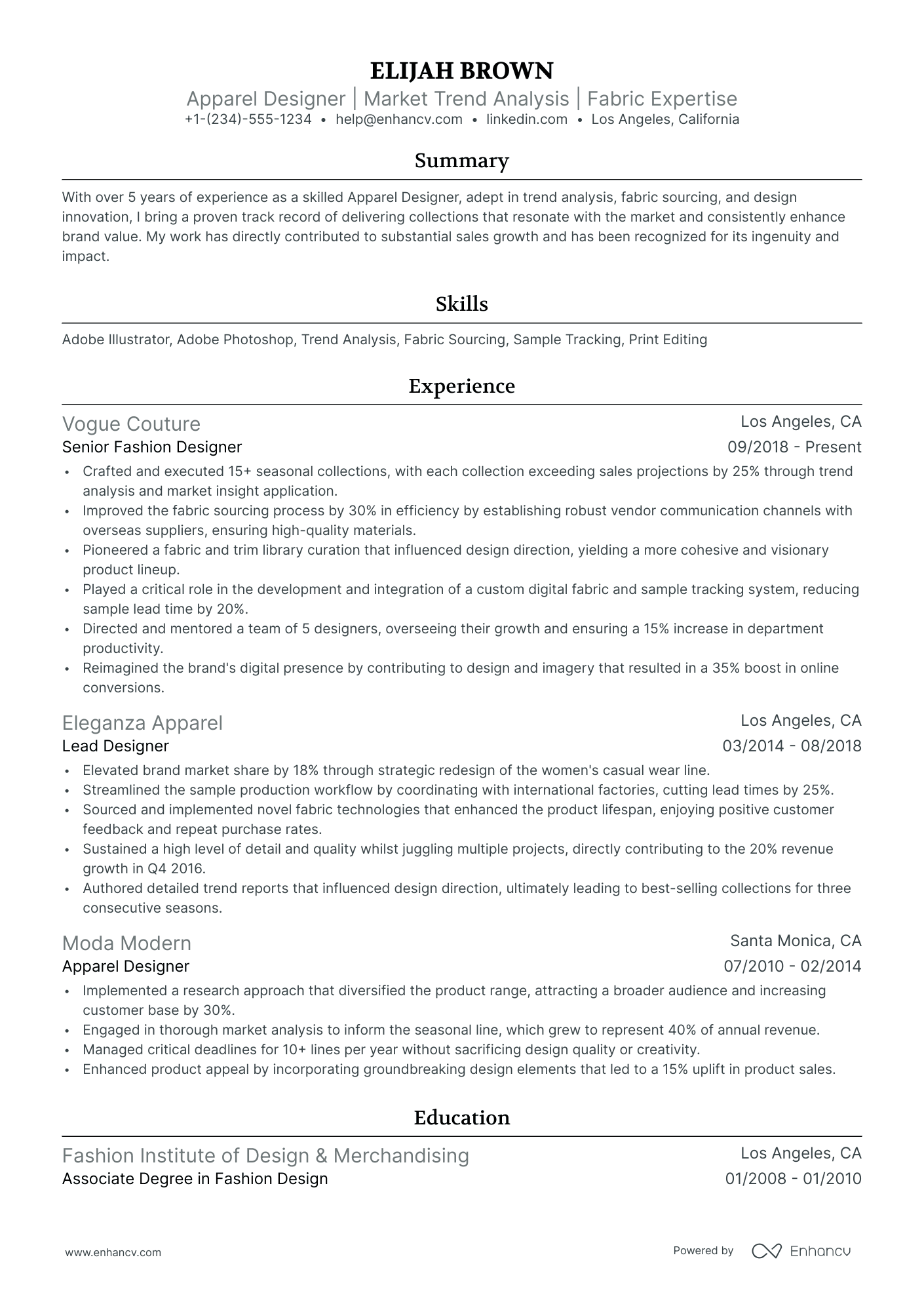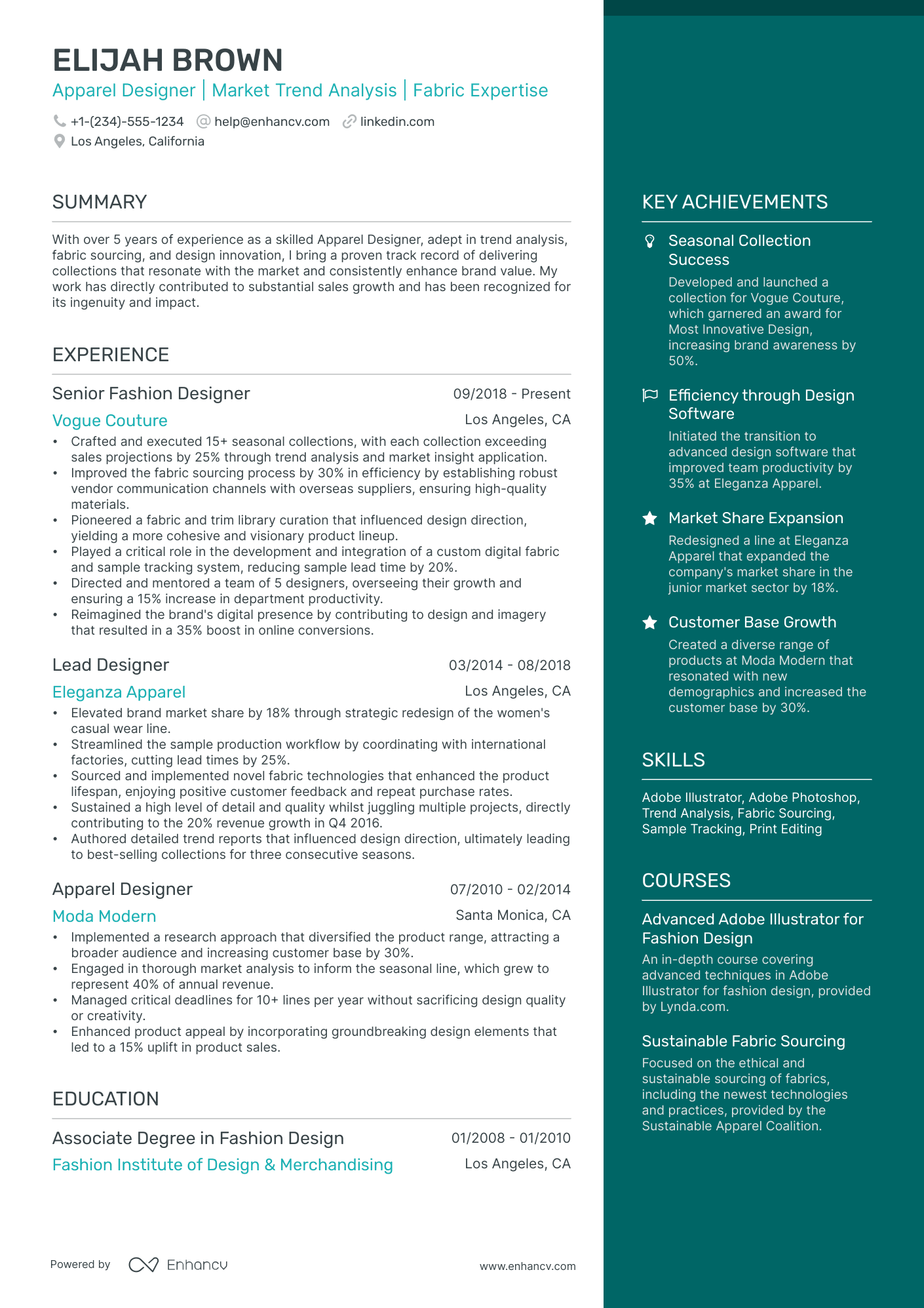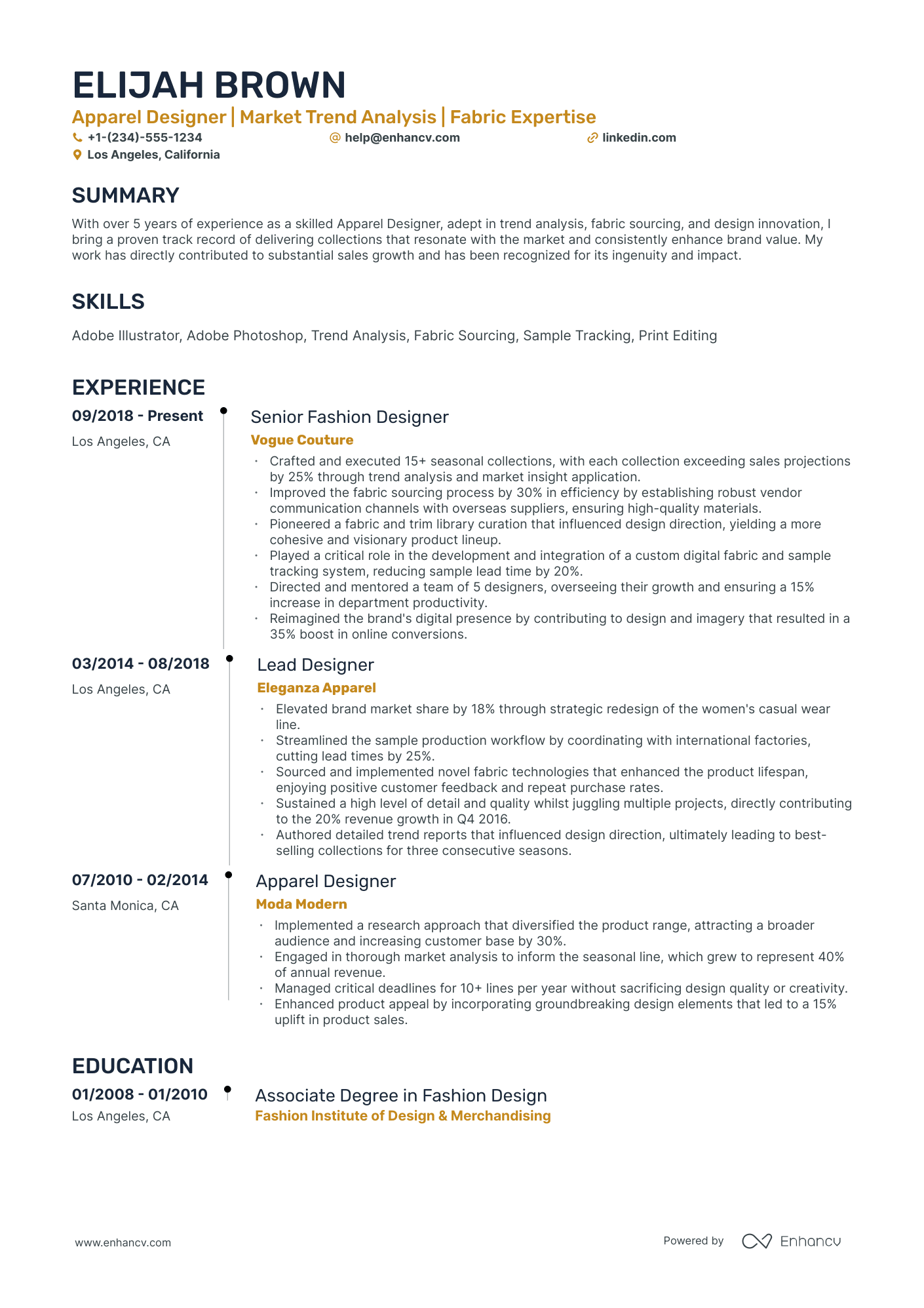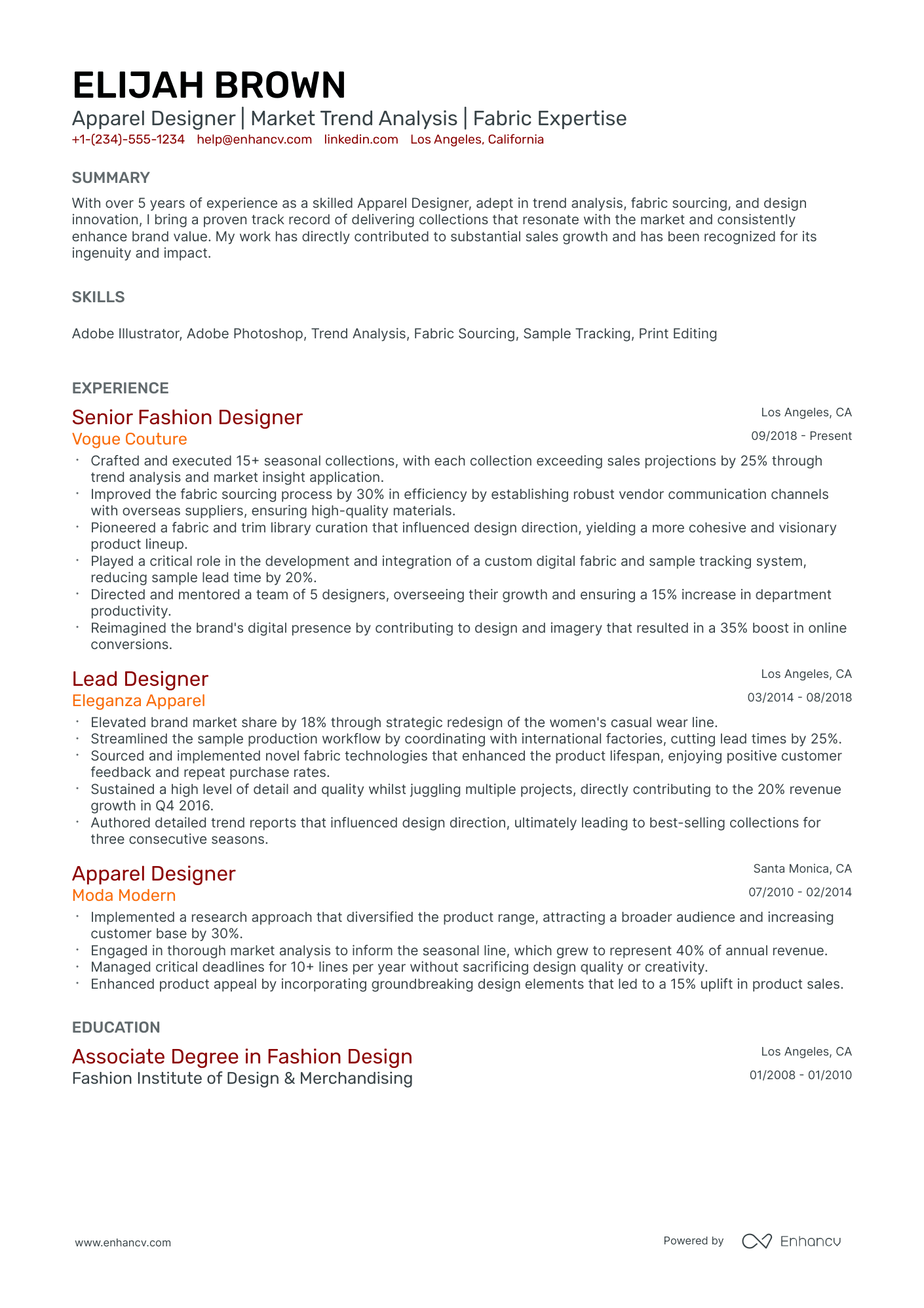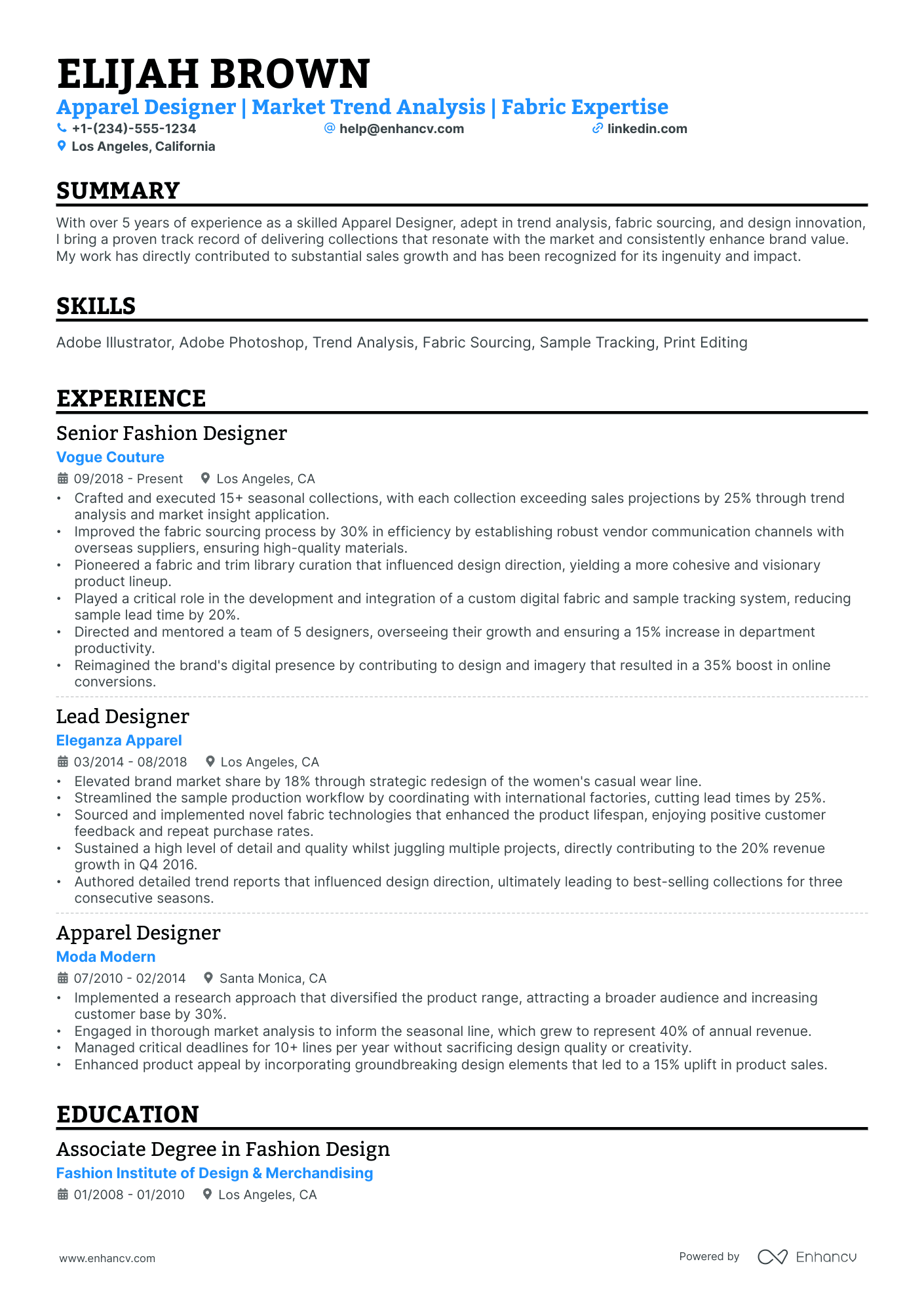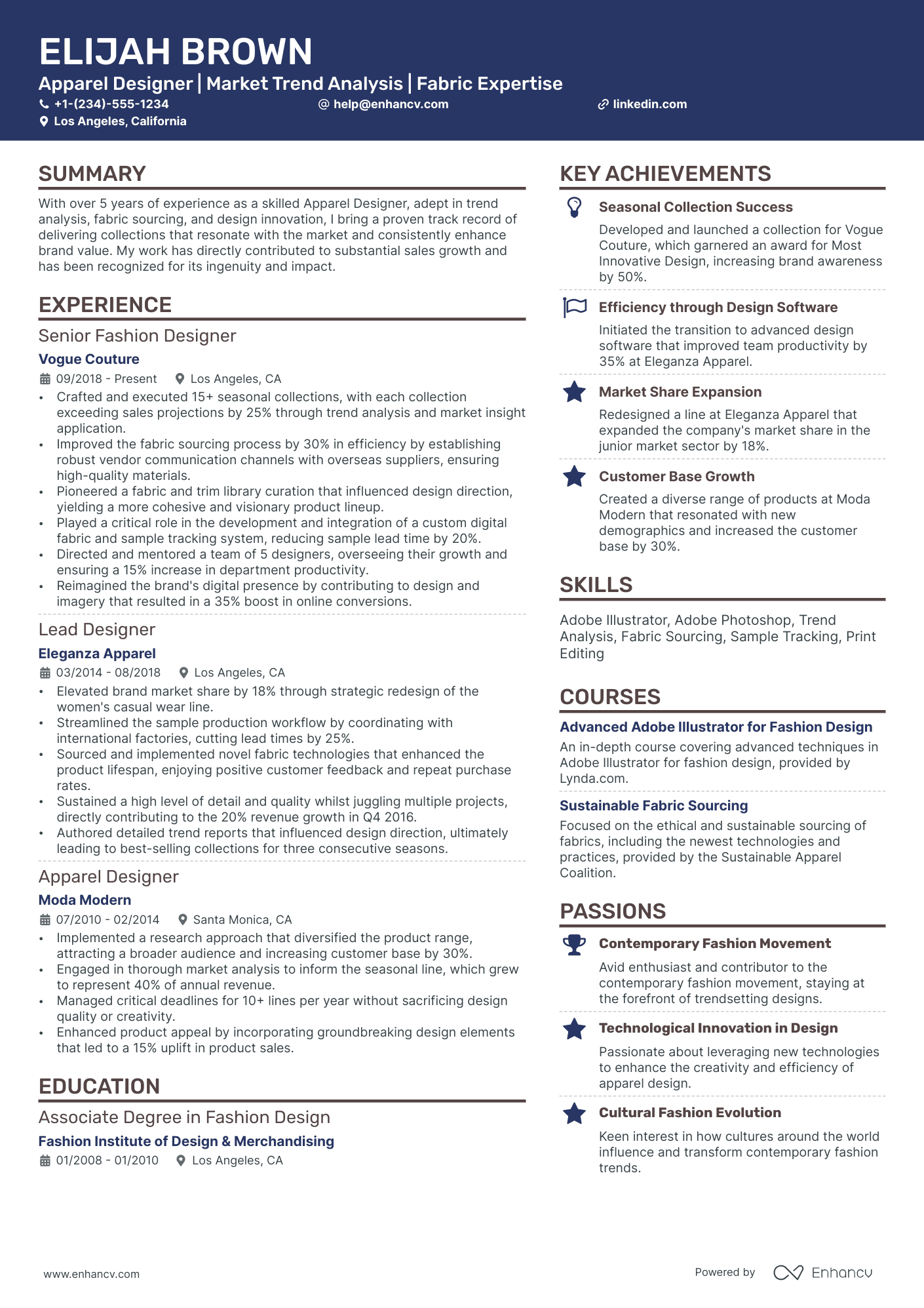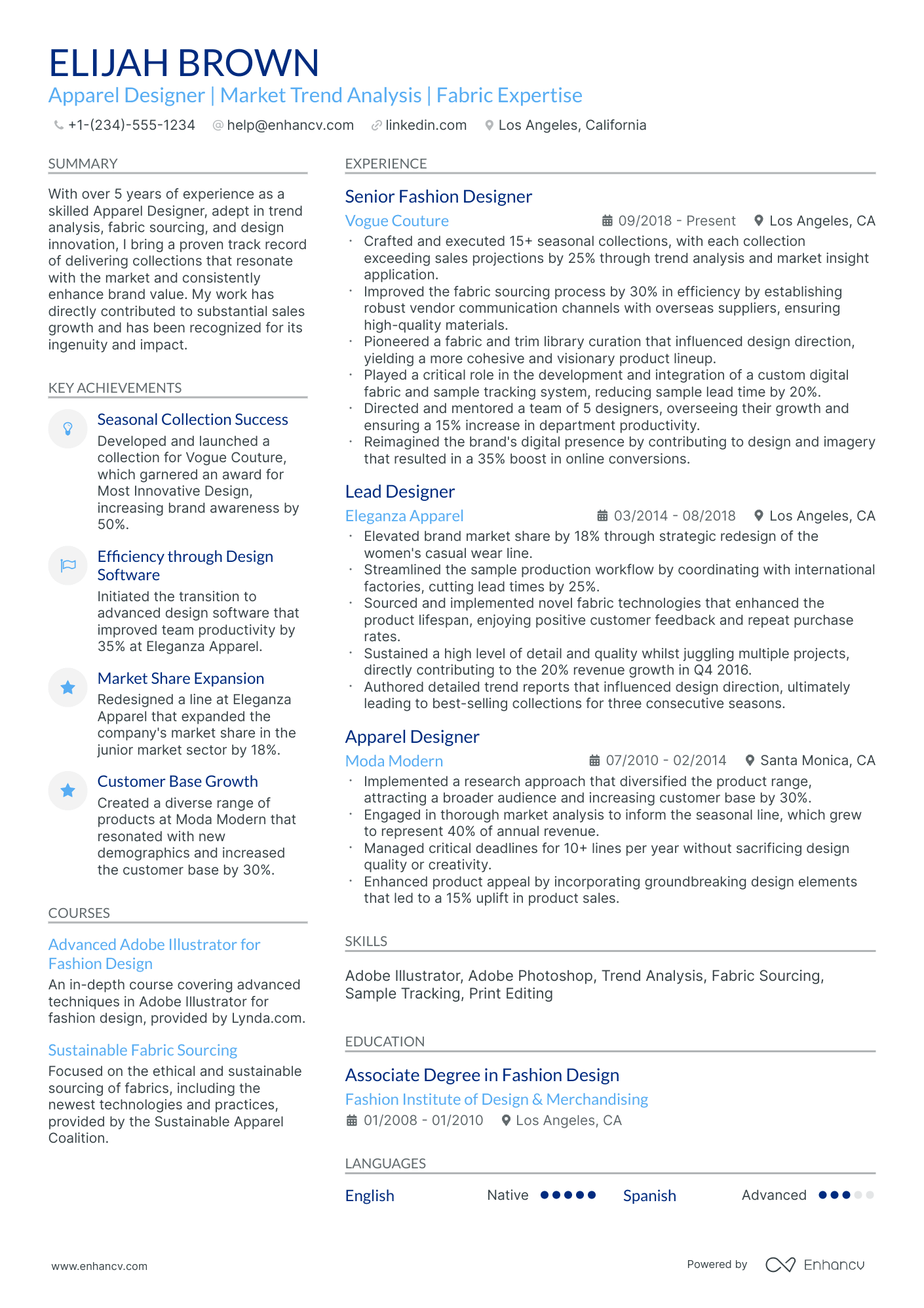As an apparel designer, a specific resume challenge you might face is presenting your diverse range of creative projects in a cohesive manner that showcases your individual style and technical skills. Our guide provides targeted advice on structuring your resume and selecting a portfolio format that highlights your strongest work, ensuring your unique talents shine through for potential employers.
- Format your apparel designer resume to ensure that it balances professionalism with creativity, and follows the best practices.
- Match the apparel designer job requirements by including industry keywords on your resume.
- Use various resume sections to showcase your skills and achievements to answer why you're the best candidate for the apparel designer role.
Take inspiration from leading apparel designer resume examples to learn how to tailor your experience.
- Associate Creative Director Resume Example
- Instructional Designer Resume Example
- Product Designer Resume Example
- Presentation Designer Resume Example
- Curriculum Designer Resume Example
- Interactive Designer Resume Example
- Multimedia Designer Resume Example
- Visual Designer Resume Example
- Jewelry Designer Resume Example
- Creative Services Manager Resume Example
Designing your apparel designer resume format to catch recruiters' eyes
Your apparel designer resume will be assessed on a couple of criteria, one of which is the actual presentation.
Is your resume legible and organized? Does it follow a smooth flow?
Or have you presented recruiters with a chaotic document that includes everything you've ever done in your career?
Unless specified otherwise, there are four best practices to help maintain your resume format consistency.
- The top one third of your apparel designer resume should definitely include a header, so that recruiters can easily contact you and scan your professional portfolio (or LinkedIn profile).
- Within the experience section, list your most recent (and relevant) role first, followed up with the rest of your career history in a reverse-chronological resume format .
- Always submit your resume as a PDF file to sustain its layout. There are some rare exceptions where companies may ask you to forward your resume in Word or another format.
- If you are applying for a more senior role and have over a decade of applicable work experience (that will impress recruiters), then your apparel designer resume can be two pages long. Otherwise, your resume shouldn't be longer than a single page.
Different markets have specific resume styles – a Canadian resume, for instance, may require a different approach.
Upload & Check Your Resume
Drop your resume here or choose a file. PDF & DOCX only. Max 2MB file size.
PRO TIP
List your educational qualifications and certifications in reverse chronological order.
Ensure your apparel designer resume stands out with these mandatory sections:
- Header - the section recruiters look to find your contact details, portfolio, and potentially, your current role
- Summary or objective - where your achievements could meet your career goals
- Experience - showcasing you have the technical (and personal) know-how for the role
- Skills - further highlighting capabilities that matter most to the apparel designer advert and your application
- Certifications/Education - staying up-to-date with industry trends
What recruiters want to see on your resume:
- Demonstrated design skills with a strong portfolio featuring examples of original apparel designs.
- Proficiency in fashion design software such as Adobe Illustrator and Photoshop, and CAD software for creating design specs.
- Knowledge of clothing construction, fabrication, and textile properties unique to apparel design.
- Understanding of current fashion trends and the ability to anticipate new ones, showcasing creativity and innovation.
- Experience with draping, pattern making, and technical design specific to creating garments.
Quick guide to your apparel designer resume experience section
After deciding on the format of your resume, it's time to organize your experience within the dedicated section.
It's common for apparel designer professionals to be confused in this part of the process, as they may have too much or little expertise.
Follow the general rules of thumb to be successful when writing this part of your resume:
- The perfect number of bullets you should have under each experience item is no more than six;
- Select not merely your responsibilities, but the most noteworthy achievements for each role that match the job requirements;
- List any certificates or technical expertise you've gained on the job and how they've helped you progress as a professional;
- Carefully select the power verbs to go along with each bullet to avoid generic ones like "managed" and instead substitute those with the actuality of your particular responsibility;
- Integrate valuable keywords from the job advert in the form of achievements under each role you list.
If you're on the search for further advice on how to write your apparel designer experience section, get some ideas from real-world professional resumes:
- Led a team of junior designers in conceptualizing a new eco-friendly sportswear line that increased the company's market share by 15%.
- Collaborated with the marketing team to develop promotional materials that enhanced product visibility and fueled a 20% sales growth.
- Implemented innovative fabric technologies to extend the lifespan of products, reducing textile waste and boosting customer loyalty by 25%.
- Designed and executed a limited-edition capsule collection for a high-profile influencer, resulting in a sold-out range within 48 hours of release.
- Developed strategic relationships with fabric suppliers to decrease material costs by 30%, while maintaining quality specifications.
- Provided consultation services on seasonal trends to small boutiques, improving their alignment with market demands and increasing their sales revenue by 18%.
- Oversaw the integration of 3D design software, shortening the product development cycle by 60 days and enhancing the accuracy of garment fit analyses.
- Mentored a design team and facilitated workshops on technical design, improving team efficiency and reducing production errors by 40%.
- Collaborated with cross-functional teams to refine sizing standards across product lines, leading to a 10% decrease in returns due to poor fit.
- Revitalized the brand's image through the successful launch of a vintage-inspired collection, driving a 30% uplift in brand engagement across social platforms.
- Managed the design process from conception to retail distribution, cutting the average time to market by 25% and solidifying brand presence in key markets.
- Expanded the brand's reach into the activewear sector by introducing a new line, increasing overall revenue by 22% within the first year.
- Developed a versatile accessories line to complement seasonal collections, boosting accessory sales by 35% and enhancing the average transaction value.
- Applied sustainable design principles to reduce material waste during production phases, aligning with corporate sustainability goals.
- Initiated a cross-departmental collaboration to fine-tune the production workflow, achieving a 20% improvement in time-to-market for new designs.
- Pioneered the use of biodegradable textiles in mainline products, distinguishing the brand as a leader in sustainable fashion practices.
- Designed a smart clothing line incorporating wearable technology, elevating brand profile within the tech-fashion market.
- Executed rigorous textile testing procedures to ensure product longevity, earning the brand recognition for durable and quality apparel.
- Researched global fashion trends to inform the design of a new urban-inspired line, increasing the company's appeal to a younger demographic.
- Cultivated an agile design approach which allowed for rapid response to fast-moving fashion trends, resulting in a 30% quicker turnaround on new designs.
- Coordinated with production units overseas to streamline operations and maintain design integrity, experiencing a reduction in manufacturing defects by 15%.
- Curated an award-winning womenswear collection that was featured in major fashion publications, significantly elevating the brand's industry status.
- Fostered a collaborative environment with fabric artisans to create unique, high-quality textiles exclusive to the brand's designs.
- Leveraged consumer insights to tailor designs to market needs, resulting in a 28% increase in sales for the womenswear category.
The following content includes information from "O*NET OnLine" by the U.S. Department of Labor, Employment and Training Administration (USDOL/ETA). Used under the CC BY 4.0 license. The data represents the top responsibilities present on the task lists for apparel designer professionals.
Top Responsibilities for Apparel Designer:
- Sketch rough and detailed drawings of apparel or accessories, and write specifications such as color schemes, construction, material types, and accessory requirements.
- Examine sample garments on and off models, modifying designs to achieve desired effects.
- Confer with sales and management executives or with clients to discuss design ideas.
- Select materials and production techniques to be used for products.
- Provide sample garments to agents and sales representatives, and arrange for showings of sample garments at sales meetings or fashion shows.
- Direct and coordinate workers involved in drawing and cutting patterns and constructing samples or finished garments.
- Identify target markets for designs, looking at factors such as age, gender, and socioeconomic status.
- Collaborate with other designers to coordinate special products and designs.
- Attend fashion shows and review garment magazines and manuals to gather information about fashion trends and consumer preferences.
- Purchase new or used clothing and accessory items as needed to complete designs.
Quantifying impact on your resume
- Include the number of fashion collections you have designed, indicating the breadth of your experience.
- Specify the percentage increase in sales due to a particular design or collection you worked on.
- List the number of design awards you have won, showcasing recognition in the industry.
- Detail the amount of money saved through cost-effective material sourcing or efficient production techniques.
- Mention the number of pieces sold from your most popular designs to demonstrate market success.
- Provide figures for the size of teams you have managed or collaborated with on projects.
- Quantify the number of client consultations you have conducted to emphasize customer engagement skills.
- State the number of technical sketches or CAD designs you have created, highlighting your technical proficiency.
Action verbs for your apparel designer resume
Lacking relevant apparel designer resume experience?
Learn how to write your apparel designer resume experience in spite of having no real-world (or applicable) experience for the job.
You should:
- Feature relevant projects or publications that could impress recruiters or showcase that you have the basic skill set for the job
- Shift the focus towards your people (communication, organization, etc.) skills to demonstrate that you're a quick learner and can easily adapt to a new environment
- Use the resume objective to not only highlight your accomplishments but also map out how your career plans are perfectly aligned with the company's vision
- Select either the functional-skill-based resume format (that puts the focus on your skills) or the hybrid one (balancing expertise with skills).
Recommended reads:
PRO TIP
If the certificate you've obtained is especially vital for the industry or company, include it as part of your name within the resume headline.
Creating your apparel designer resume skills section: balancing hard skills and soft skills
Recruiters hiring for apparel designer roles are always keen on hiring candidates with relevant technical and people talents. Hard skills or technical ones are quite beneficial for the industry - as they refer to your competency with particular software and technologies. Meanwhile, your soft (or people) skills are quite crucial to yours and the company's professional growth as they detail how you'd cooperate and interact in your potential environment. Here's how to describe your hard and soft skill set in your apparel designer resume:
- Consider what the key job requirements are and list those towards the top of your skills section.
- Think of individual, specific skills that help you stand out amongst competitors, and detail how they've helped you succeed in the past.
- Look to the future of the industry and list all software/technologies which are forward-facing.
- Create a separate, technical skills section to supplement your experience and further align with the apparel designer job advert. Find the perfect balance between your resume hard and soft skills with our two lists.
Top skills for your apparel designer resume:
Adobe Illustrator
Adobe Photoshop
CAD Software
Pattern Making
Sewing Techniques
Textile Knowledge
3D Design Software
Adobe InDesign
Technical Drawing
Fashion Design Software
Creativity
Attention to Detail
Communication
Time Management
Team Collaboration
Problem-Solving
Adaptability
Critical Thinking
Trend Analysis
Project Management
Next, you will find information on the top technologies for apparel designer professonals from "O*NET OnLine" by the U.S. Department of Labor, Employment and Training Administration (USDOL/ETA). Used under the CC BY 4.0 license.
Top technologies for Apparel Designer’s resume:
- Autodesk Revit
- Trimble SketchUp Pro
- Microsoft PowerPoint
- Adobe Creative Cloud software
- Adobe Illustrator
PRO TIP
List your educational qualifications and certifications in reverse chronological order.
The basics of your apparel designer resume certifications and education sections
Improve the education and certification sections of your apparel designer resume by:
- Dedicating more prominent space to certificates that are more recent and have helped you update your skill set
- Keeping all the information you list to the basics: certificate/degree name, institution, and graduation dates
- Writing supplementary information in the details of your certification or education section, only if you lack experience or want to show further skill alignment
- Including your credential or license number, only if the information is valid to your application or certification
Within apparel designer job adverts, relevant education, and certification are always listed within the key prerequisite for the role.
Ensure you meet all job requirements with some of the leading certificates in the industry:
The top 5 certifications for your apparel designer resume:
- Associate apparel designer (AAD) - Fashion Institute of Technology (FIT)
- Certified Technical Designer (CTD) - Apparel Industry Association
- Professional Design Certification (PDC) - American Apparel & Footwear Association (AAFA)
- Advanced Fashion Design Certificate (AFDC) - Parsons School of Design
- Master Pattern Maker (MPM) - Fashion Institute of Design & Merchandising (FIDM)
The content below includes information from "O*NET OnLine" by the U.S. Department of Labor, Employment and Training Administration (USDOL/ETA). Used under the CC BY 4.0 license. The data represents the top associations for apparel designer professionals.
Top US associations for a Apparel Designer professional
- Costume Designers Guild
- Council of Fashion Designers of America
- Fashion Group International
- National Association of Schools of Art and Design
- The Underfashion Club
PRO TIP
If you happen to have plenty of certificates, select the ones that are most applicable and sought-after across the industry. Organize them by relevance to the role you're applying for.
Recommended reads:
Deciding between a resume summary or objective for your apparel designer role
Understanding the distinction between a resume summary and an objective is crucial for your apparel designer resume.
A resume summary, typically three to five sentences long, offers a concise overview of your career. This is the place to showcase your most pertinent experience, key accomplishments, and skills. It's particularly well-suited for those with professional experience relevant to the job requirements.
In contrast, a resume objective focuses on how you can add value to potential employers. It addresses why they should hire you and outlines your career expectations and learning goals. Therefore, it's ideal for candidates with less experience.
In the following section of our guide, explore how resume summaries and objectives differ through some exemplary industry-specific examples.
Resume summaries for a apparel designer job
- With over 10 years of dedicated experience in high-end fashion design, adept in pattern making, draping, and textile selection, I have successfully led a large design team at Renown Couture House, consistently delivering collections that increased sales by 20% year-on-year.
- Seasoned apparel designer with a robust 15-year portfolio, skilled in Adobe Illustrator and Photoshop, who has crafted award-winning designs for outdoor sports apparel, enhancing brand visibility and customer loyalty for Peak Performance Activewear.
- Former visual artist with a 5-year journey in a highly creative environment, I bring a unique perspective on trend-forecasting and design conceptualization, seeking to transition these skills into apparel design to create stunning, memorable pieces for everyday wear.
- Transitioning Architect, leveraging 8 years of experience in structure and form, looking to infuse my strong background in sustainable design and material innovation into the world of apparel, merging functionality with aesthetic appeal for the modern consumer.
- Eager to embark on a career journey in apparel design, my objective is to utilize my recent degree in Fashion Design and intern experience to contribute fresh, innovative ideas to a forward-thinking design team, fully committed to environmentally conscious creations.
- As an aspiring apparel designer and recent graduate with a Bachelor in Fashion Design, my goal is to apply my knowledge of the latest 3D design technology to produce dynamic, wearable art that resonates with contemporary style influencers and audiences.
Optimize your resume summary and objective for ATS
Drop your resume here or choose a file.
PDF & DOCX only. Max 2MB file size.
Average salary info by state in the US for apparel designer professionals
Local salary info for Apparel Designer.” Source: My Next Move, National Center for O*NET Development. Accessed 10/15/2024
| State | Average Salary (in USD) |
|---|---|
| US National Average | $79,290 |
| Texas (TX) | $35,150 |
| Florida (FL) | $60,430 |
| New York (NY) | $80,780 |
| Pennsylvania (PA) | $78,720 |
| Illinois (IL) | $63,970 |
| Ohio (OH) | $79,500 |
| Georgia (GA) | $79,560 |
| North Carolina (NC) | $64,750 |
| Michigan (MI) | $56,660 |
More relevant sections for your apparel designer resume
Perhaps you feel that your current resume could make use of a few more details that could put your expertise and personality in the spotlight.
We recommend you add some of these sections for a memorable first impression on recruiters:
- Projects - you could also feature noteworthy ones you've done in your free time;
- Awards - showcasing the impact and recognition your work has across the industry;
- Volunteering - the social causes you care the most about and the soft skills they've helped you sustain and grow;
- Personality resume section - hobbies, interests, favorite quote/books, etc. could help recruiters gain an even better understanding of who you are.
Key takeaways
Writing your apparel designer resume can be a structured and simple experience, once you better understand the organization's requirements for the role you're applying to. To sum up, we'd like to remind you to:
- Always select which experiences, skills, and achievements to feature on your resume based on relevancy to the role;
- In your resume summary, ensure you've cherry-picked your top achievements and matched them with the job ad's skills;
- Submit your apparel designer resume as a one or two-page long document at the most, in a PDF format;
- Select industry leading certifications and list your higher education to highlight you have the basis for technical know-how;
- Quantify your people's skills through various resume sections (e.g. Strengths, Hobbies and interests, etc.) to show recruiters how your profile aligns with the organizational culture.
